Реферат ученицы школы №1
| Вид материала | Реферат |
- Реферат ученицы 5 класса Кайгородовой Алены на тему «Свадебные обряды якутов», 13.03kb.
- Реферат по английскому языку ученицы 8 «А» класса Седовой Анны, 804.91kb.
- Работа «Санкт-Петербург и традиции моей семьи» ученицы 2-а класса школы №611 г. Зеленогорска, 46.87kb.
- История развития английского языка. Заимствования, 336.05kb.
- Викторина. Добродушные великаны, 10.36kb.
- Реферат ученицы 8 «А» класса, 184.06kb.
- Реферат ученицы, 300.27kb.
- Реферат ученицы 9 класса «А» Генерозовой Марии по теме: «Личность Джамухи», 291.41kb.
- Реферат по истории Псковского края ученицы 9а класса, 335.63kb.
- Реферат по истории ученицы 10 класса Егоровой Анастасии. Санкт-Петербург, 2005г, 585.09kb.
Реферат ученицы школы №1
Щукиной Е
Учитель Штукатурова Н.А.
The birthplace of valour ,
The country of worth!
R.Burns
What do we know about Scotland? We know so little, that it is the part of the United Kingdom. It is famous for Loch Ness, tartan kilts, Scottish dancing, Scottish bagpipe and, of course, it’s people-strong and brave, courageous, independent .
When I think about Scotland, I imagine a beautiful landscape -green hills with white sheep, the Highlands and the poem of Robert Burns “My heart’s in the Highlands”.
My heart’s in the Highlands, my heart is not here,
My heart’s in the Highlands, a-chasing the deer,
A-chasing the wild deer and following the roe-
My heart’s in the Highlands, wherever I go!
Farewell to the Highlands, farewell to the North,
The birthplace of valour ,the country of worth!
Wherever I wonder, wherever I rove,
The hills of the Highlands for ever I love.
I also remember the national hero Wallace and the film of Mel Gibson “The Brave heart.” Scottish people were once brave and rugged warriors, nowadays they are peace loving.
Scotland is so mysterious and mystical. I would like to get more information about Scotland and Scottish people, about their traditions and history. This is the aim of my research. I would like to understand the spirit of Scotland. They say, “If you understand Scotland, you understand life.” That is why I have chosen this theme “Discovering Scotland.” Let me start my discovering of this unique part of the United Kingdom.
^ SCOTLAND GEOGRAPHY
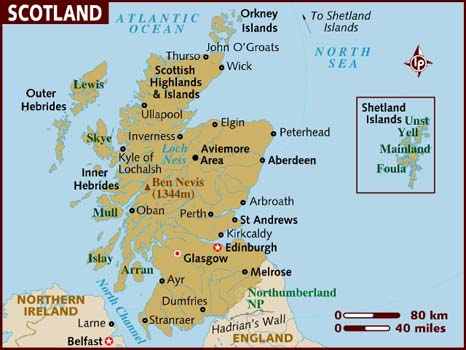 Scotland is approximately half the size of England. It is 440 km from north to south and 248 km from east to west - yet has about 10000 km of coastland. Due to the indented nature of the coastline, the furthest you can be from salt water is about 62 km! Scotland is not far away from the Arctic Circle as it lies between 55 and 60 North.
Scotland is approximately half the size of England. It is 440 km from north to south and 248 km from east to west - yet has about 10000 km of coastland. Due to the indented nature of the coastline, the furthest you can be from salt water is about 62 km! Scotland is not far away from the Arctic Circle as it lies between 55 and 60 North.The total Area is 78.772 sq km, representing 32% of the UK area. The urban area is 3% of total area. The highest mountains are Ben Nevis - 1, 344 m, Ben Macdhui -1,309 m, Braeriach - 1,296 m, Cairn Toul - 1,291, Cairn Gorm - 1,244 m.
The lochs represent 2% of total area , there are over 31,400 of them: Lomond - 71sq km, Ness - 56, Awe -38, Maree -29, Morar -27, Tay -26. “Loch” means “lake”. The most famous and mysterious of the Scottish lochs is Loch Ness. In spite of numerous expeditions to find Nessie the mystery has not been solved yet.
There are many rivers in Scotland but they are not long. The longest rivers are the Tay -193 km long, the Spey -172, the Clyde -171, the Tweed -156, the Dee -137, the Don -132, the Forth -105 km. long.
 Scotland is split into two natural section, the Highlands and Lowlands, split by the Highland Boundary Line - a geological fault which runs from Helenburgh, on the Clyde estuary, in the south west, to Stonehaven, south of Aberdeen, in the north east.
Scotland is split into two natural section, the Highlands and Lowlands, split by the Highland Boundary Line - a geological fault which runs from Helenburgh, on the Clyde estuary, in the south west, to Stonehaven, south of Aberdeen, in the north east. The Highland is a sparsely populated area with mountains rising to over 4000 ft. In fast two thirds of Scotland is either mountains or moor land. The Highlands is the largest council area within Scotland and also the least densely populated due to the nature of the landscape with its many mountains and lochs.
Although Scotland takes up 1/3 of the territory of the UK , its population is not very big.
PEOPLE FACTS . Population: ~ 5.15 million, 48% male, 52% female
Urban areas: Glasgow~700,000; Edinburgh~400,000: Aderbeen~200,000: Dunbee~150,000 people.
Religion: Roman Catholic-14.0%, Church of Scotland (Presbyterian) -13.0%, Episcopal-1.0%, Other Christian-1.5%, Muslim-0.5%, Hebrew-0.1%.
^ CLYDE RIVER
J
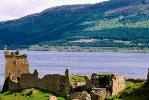 ust as the United States has its Mississippi and England has its Old Father Thanes, Scotland has its River Clyde - a river justly famed throughout the world. Beginning as a fishing stream in the Southern Upland, the river flows to its estuary at the Firth of Clyde. For 20 miles of its journey, the banks of the Clyde at Glasgow for over 1000 years were home to the world’s largest shipbuilding industry. It is to Scottish shipbuilding, that Scotland’s identity, as an industrial nation is owed. In 1831, when pioneering construction enterprises first began, the Clyde provided for 3 percent of the men engaged in shipbuilding Britain. By 1871 this had jumped to 21 percent and the Clyde represented the signal largest concentration of ship building in the world. The mighty Clyde saw building of approximately 30 000 ships in less than 200 years.
ust as the United States has its Mississippi and England has its Old Father Thanes, Scotland has its River Clyde - a river justly famed throughout the world. Beginning as a fishing stream in the Southern Upland, the river flows to its estuary at the Firth of Clyde. For 20 miles of its journey, the banks of the Clyde at Glasgow for over 1000 years were home to the world’s largest shipbuilding industry. It is to Scottish shipbuilding, that Scotland’s identity, as an industrial nation is owed. In 1831, when pioneering construction enterprises first began, the Clyde provided for 3 percent of the men engaged in shipbuilding Britain. By 1871 this had jumped to 21 percent and the Clyde represented the signal largest concentration of ship building in the world. The mighty Clyde saw building of approximately 30 000 ships in less than 200 years. The story is told of a young lad arriving in Glasgow for the first time and asking a policemen, “Can I get from here to Kelvinsgrove?” The answer was “Laddie, you can get from here to any place in the world.”
^ SCOTLAND’S CLIMATE
Weather: average sea level temperature of ~9 degrees (min -30/max +30).
The highest recorded temperature in Scotland was 32.9*C at Grey crook (Scottish
Borders) on 9 August, 2003. Prior to that, the record was 32,8*C at Dumfries in 1908.The coldest daytime temperature in Scotland was -27.2*C at Braemar on 11 February 1985.The wettest day recorded in Scotland was on 17 January 1974 when 238mm fell at Sloy Dam, Loch Lomond.
In the sunniest parts of Scotland (Angus, Fife, Lothians, Ayrshire, Dumfries & Galloway) there is an average of 1,400 hous of sunshine each year. Even in the mountain regions of the Highlands there are over 1,000 hours of sunshine a year.
Dunbar holds the record for the highest annual total of sunshine-1,523 hours. The western Highlands, facing the prevailing westerly winds from the Atlantic, are the wettest parts of Scotland with over 3,000mm of rain a year (some rain falling on over 250 days each year). By contrast, the east coast and the Moray Firth area in particular, have the lowest rainfall-less than 650mm. Rains fall 200 days per year, in the western coast 250 days per year. Snow falls from 5 to 70 days per year.
PLANTS
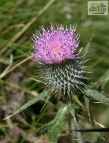 The nature in Scotland is very beautiful and charming. The most traditional plants are the heather and the thistle. The symbol of the country is a thistle.The plants produce a large rosette of spiny, silvery - white foliage during the first year of growth. The following year thick triangular stems grow up to 6 feet tall and are topped with lavender thistle - like flowers.
The nature in Scotland is very beautiful and charming. The most traditional plants are the heather and the thistle. The symbol of the country is a thistle.The plants produce a large rosette of spiny, silvery - white foliage during the first year of growth. The following year thick triangular stems grow up to 6 feet tall and are topped with lavender thistle - like flowers. E
 very schoolchild in Scotland learns the legend of how the thistle, their national emblem, saved the country in the Middle Ages, when the Scots and Norsemen were at war. Under cover of darkness, the Norsemen managed to land unobserved on the coast of Scotland. Removing their boots, they crept on bare feet toward the unsuspecting Scottish army. Suddenly, a sharp cry of pain shattered the stillness: a Norse soldier had stepped on a thistle. Thus alerted to the surprise attack, the Scots sprang into action and drove the invaders from their shores.
very schoolchild in Scotland learns the legend of how the thistle, their national emblem, saved the country in the Middle Ages, when the Scots and Norsemen were at war. Under cover of darkness, the Norsemen managed to land unobserved on the coast of Scotland. Removing their boots, they crept on bare feet toward the unsuspecting Scottish army. Suddenly, a sharp cry of pain shattered the stillness: a Norse soldier had stepped on a thistle. Thus alerted to the surprise attack, the Scots sprang into action and drove the invaders from their shores. ^ How did Scotland get its name?
Scotland gets its name from the Scotti who first arrived in the late 3rd to mid 4rt centuries AD. It was not until about they built up a sizeable colony, though. The Scots spoke Irish, not Scots. Scots is a Germanic language, like English.
Scotland is not a wholly Celtic country, since from the first millennium BC, it has been a place of multiple languages. The tradition continues today. First jf all Scotland was Pictish and British; then Gaelic Norse and Scots came next, and today it’s English, Scots and Gaelic.
Nearly all of Scotland was once Gaelic-speaking except Orkney, Shetland and Caithness which had a variety of Norse until resent times and East Lothian which was settled by the Angles. Galloway had a Gaelic community which became separated from the Gaelic-speaking Highland and Gaelic was still in use until about the 17th century in Galloway.
What do you call people living in Scotland? We call them Scot, Scotch-Irish, Scotchman/woman, Scottish.
^ HISTORIC LANGUAGES OF SCOTLAND
During Roman times two main languages were documented in Scotland. In the south the language was British, probably close to Welsh. In the north Pictish was spoken, which appears related to continental Gaulish, possibly brought by refugees of early Roman expansion.
“^ Scottish English”
English is currently Scotland’s first language, a tongue it shares with the world. However, the English spoken in Scotland is unique, and very different from other Englishes. The English language in Scotland has been permeated by the influence of Scots.
Some Scottish words and expressions are used and understood across virtually the whole country. Among them are:
^ Dinnae (don’t) Lassie (girl) Wee (small) Bairn (child)
Cannae (can’t ) Laddie (boy) Aye (yes) Bonny (pretty)
Languages Today . In the 21st C. all Scots can speak, read and write English. Around 3.5 million can understand pure Scots but many do not use it as their first language. Most use a mix of Scots and English in daily speech. About 70000 understand Gaelic but it is now a first language only in the Western Isles of about 30000 speakers.
S
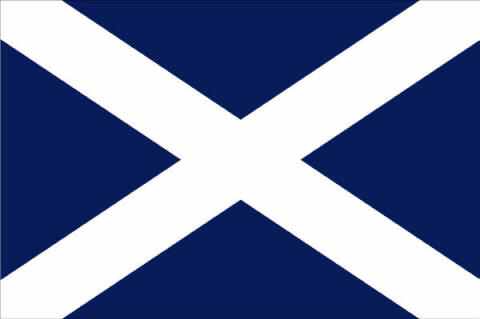 ^ COTTISH FLAG .Legend says that in 832 AD, an army of Scots was facing a Northumbrian army. The Scottish king prayed to St. Andrew for help, and saw the saltire of St. Andrew in the heavens against a clear blue sky. On seeing the cross in the sky, he swore that if the Scots beat the English in the battle, then St. Andrew would forever be the patron saint of Scotland. The Scots did in fact win the battle, and from that day on the saltire has been the national flag of Scotland.
^ COTTISH FLAG .Legend says that in 832 AD, an army of Scots was facing a Northumbrian army. The Scottish king prayed to St. Andrew for help, and saw the saltire of St. Andrew in the heavens against a clear blue sky. On seeing the cross in the sky, he swore that if the Scots beat the English in the battle, then St. Andrew would forever be the patron saint of Scotland. The Scots did in fact win the battle, and from that day on the saltire has been the national flag of Scotland. What are the Scottish Royal Regalia? Remember that whish the death of Queen Elizabeth I, King James of Scotland acceded to the English throne, uniting the two kingdoms. Therefore the panoply of the Scottish monarchy exists a from separate from the English Crown Jewels. They are to be seen in Edinburgh Castle.
^ The Crown. It is not known exactly how old this crown is. It was remodeled by James v in 1540. it is accepted that it is made from the Crawford Moor mine, actively worked at this time.
The Scepter. A gift from the Pope to James IV in 1494. It too was remodeled by James V, who seemed to have liked the jewellery, and even added his initials to the scepter. The globe of the scepter is a cut and polished rock crystal, with a Scottish pearl on top.
The Sword of State. Another gift from another pope to James IV in 1507. A fine example of craftsmanship, it came come complete with swordbelt and a consecrated hat. The blade of the sword is a metre long.
Following the Treaty of Union in 1707, the ancient crown jewels of Scotland disappeared for a century, nobody knew what had happened to them. Rumours circulated that the English had removed them to London.
In 1818 Sir Walter Scott obtained permission from the Prince Regent ( later George IV ) to search Edinburgh castle for the Royal Scottish regalia. The searchers eventually found them locked in an oak chest, covered with linen cloths, exactly as they had been left in 1707.
What is the Stone of Destiny (Scone )? Legend says that the Stone of Destiny was used by Jacob (in the Bible) as a pillow. It was believed to have been brought to Scotland in the 9th century. The Stone was used as part of the crowning ceremonies of the kings of Dalriada, in the 36th king moved his capital to Scone around 840 AD/ the Stone of Destiny was moved there, too. Coronations of Scottish kings took place at Scone Palace. John Balliol was the last Scottish king to be crowned on the Stone at Scone in 1292.
It was taken away by King Edward I of England in 1296 and remained under the Coronation Throne at Westminster Abbey in London of 700 years. Now there is only a replica at Scone Palace.
On December 25, 1950 a group of Scottish Nationalists stole the Stone and brought it back to Scotland for four months before it was returned. The stone finally came home to Scotland on St. Andrew’s Day/ 30 November 1996/ and is housed beside the other Honours of Scotland in Edinburgh Caste.
In the event of a future coronation of a British monarch, the Stone of Destiny is to be temporarily replaced under the Coronation Throne at Westminster Abbey.
^ Does Scotland issue its own money?
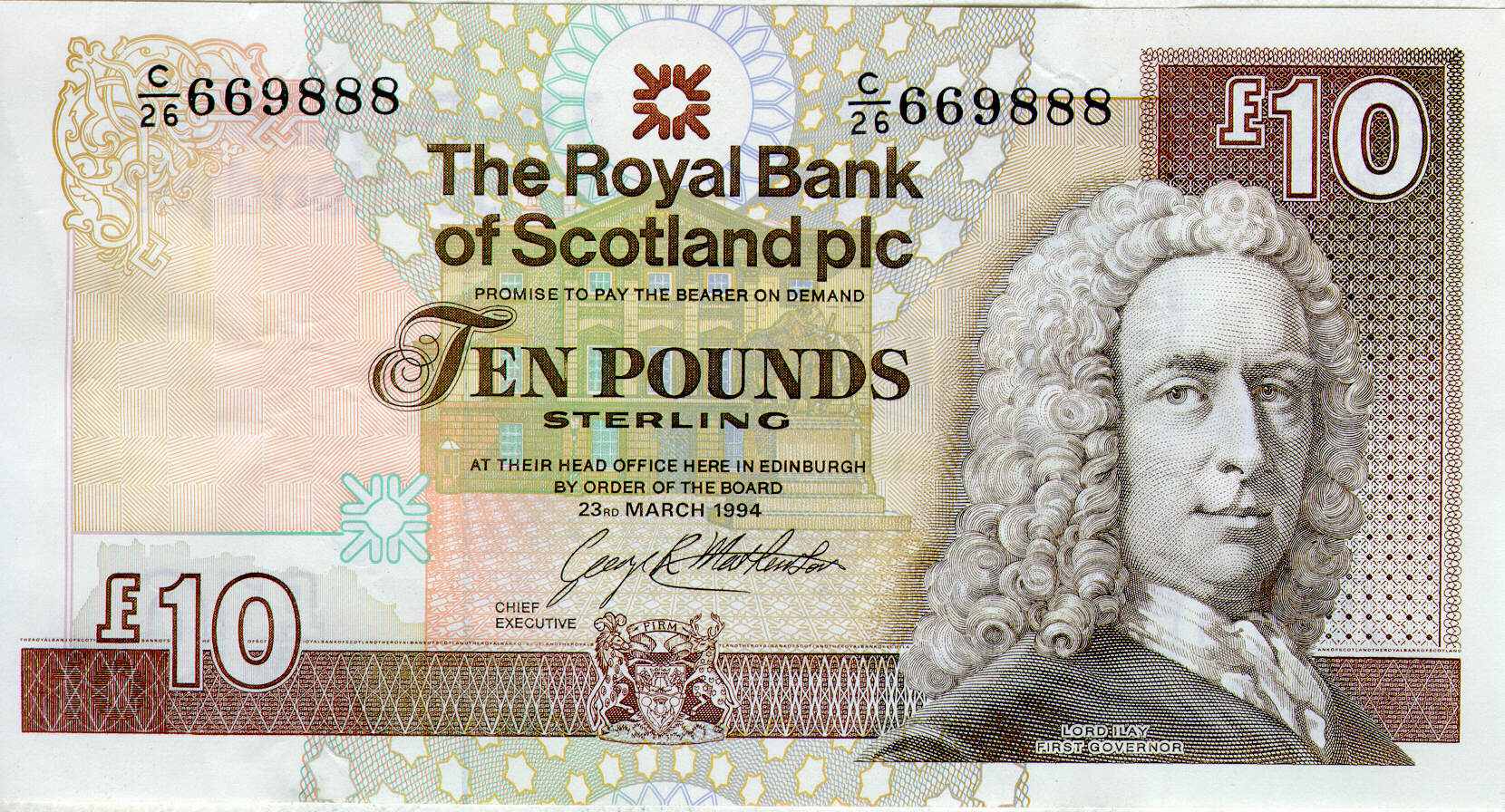 Scottish banks have issued banknotes continuously since 1695. Only the Royal Bank Scotland still designs and prints their own pound notes. Scottish banknotes are used every day and about 95% of the notes in circulation in Scotland come from Scottish banks. Sometimes Scottish notes travel to England and Wales and they are usually accepted there. Scottish banks do not produce coins – the British Royal Mint has a monopoly on that.
Scottish banks have issued banknotes continuously since 1695. Only the Royal Bank Scotland still designs and prints their own pound notes. Scottish banknotes are used every day and about 95% of the notes in circulation in Scotland come from Scottish banks. Sometimes Scottish notes travel to England and Wales and they are usually accepted there. Scottish banks do not produce coins – the British Royal Mint has a monopoly on that. ^ Is “Mac “Scottish and “Mc” Irish? Mac and Mc do not indicate Scottish or Irish origins. They are both exactly the same word, the Mc is actually the abbreviated form of Mac and was usually written M’c (sometimes even M”) with the apostrophe indicating that the name has been abbreviated. There is, however, one distinction to make as far as differentiating between a name being Scottish of Irish. If it is an O’ name it is always Irish (those in Scotland are mostly 19th century emigrations0, but if it is a Mac, Mc or other variation it can be either Scottish or Irish!
^ What is a Ceilidh? A Ceilidh? (pronounced “kay-lay”) is many things. It derives from the Gaelic word meaning “a visit “and originally meant just that. It can also mean a house party, a concert or more usually an evening of informal Scottish traditional dancing to informal music. Ceilidhs is the Lowlands tend to be dances, in the Highlands they tend to be concerts.
Ceilidh dancing is fundamentally different from Scottish Country Dancing in that it is less formal and the primary purpose is enjoyment. Scottish Country Dancing is much more oriented towards being a demonstration of exhibition. Ceilidhs are extremely popular with young people and often attract from a few dozen people to several hundred. There are world championships for ceilidh bands now. Ceilidhs are also part of Hogmanay.
^ SAINT ANDREW
Saint Andrew is the patron saint of Scotland, Romania and Russia and was Christ’s first disciple. Saint Andrew is the Patron Saint of Scotland, and St. Andrew’s day is celebrated by the Scots around the world on November 30 each year. The original Andrew was a fisherman in the Holy Land, one of the 12 disciples of Jesus helping to spread the Christian faith.
He is believed to have beer martyred at a place called Patras in Greece, crucified by a Roman governor on an X-shaped cross that was become the inspiration for the cross that form the Saltire, Scotland’s national flag. His bones were entombed until, 300 years later, the Emperor Constantine the Great decreed they should be moved to his new capital of Constantinople (Istanbul) in Turkey.
Legend has it that before Constantine’s orders could be carried out, a monk, who was called St. Rule, was warned in a dream. An angel told him to take what bones he could to the “ends of the earth” for safe-keeping. The monk removed a tooth, an arm bone, a kneecap and some fingers from Saint Andrew’s tomb and set out on an epic journey. He was shipwrecked off Scotland and washed ashore with his precious cargo at a Pictish settlement that was soon to become known as St. Andrews.
Another version of the story is that Acca, Bishop of Hexham, a renowned collector of relics, brought them to St. Andrews in the 7th century. There certainly seems to have been a religious centre at St. Andrews at that time.
Whatever the truth, the relics were placed in a specially constructed chapel on the same site as the Cathedral of St. Andrews which was built in the 11th century. At that time St. Andrews was the religious capital of Scotland and a great centre for Medieval pilgrims who came to view the relics. It is not known what happened to the relics of St. Andrew which were stored there, although in is most likely that these were destroyed during the Scottish Reformation when many churches were ransacked destroyed.
The larger part of St. Andrew’s remains were stolen from Constantinople in 1210 and are not to de found in Southern Italy. In 1879 the Archbishop of Amalfi sent a small piece of the Saint’s shoulder blade to the re-established Roman catholic community in Scotland.
During his visit to Scotland in 1969, Pope Paul VI gave further relics of St. Andrew to Scotland with the words “Saint Peter gives you his brother” and these are now displayed in a reliquary in St. Mary’s Roman Catholic Cathedral in Edinburgh.
The chivalric Order of Saint Andrew also know as the Most Ancient Order of the Thistle, was created by James VII in 1687 and is an order of Knighthood restricted to the King or Queen and 16 others.
St. Andrew is also the patron saint of Russia. It is said he can best be invoked against gout and a stiff neck.
^ THE MAJOR SCOTTISH CITIES
EDINBURGH
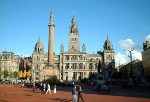 “Edinburgh”, said writer Robert Louis Stevenson, “is what Paris ought to be”. The city of Edinburgh, affectionately known as “Auld Reekie” (Old Smokey) is the histories, cosmopolitan and culture capital of Scotland. Stevenson called his city “This profusion of eccentricities, this dream in masonry and living rock is not a drop-scene in a theatre, but a city in the world of reality”.
“Edinburgh”, said writer Robert Louis Stevenson, “is what Paris ought to be”. The city of Edinburgh, affectionately known as “Auld Reekie” (Old Smokey) is the histories, cosmopolitan and culture capital of Scotland. Stevenson called his city “This profusion of eccentricities, this dream in masonry and living rock is not a drop-scene in a theatre, but a city in the world of reality”.Edinburgh was originally known as Din Eidyn , the Fort of Eidyn until 638- a reference to the fort that stood where the castle now stands. It became a town and a royal burgh in the 12th Century and in 1329 Robert the Bruce gave the town jurisdiction over the Port of Leith. The burgh was enclosed within the Flodden Wall after 1513 . For 200 years the wall marked the boundary of Edinburgh and as a result restricted development, and it grew up, instead of out , as the population increased. The town became overcrowded, so expansion was required. Land to the north Old Town was cleared for the building of the New Town.
The commanding castle, high on its impregnable rock in the south, looks down upon the many spires and turrets that make up the Old City, a truly medieval mix of churches, chapels, cathedrals, law offices, government buildings, royal residences and tenement houses. At one end of the Royal Mile lie the Castle ramparts; at the other end is the magnificent Palace of Holyrood house, where Mary, Queen of Scots, returned from France tried to turn back clock. It is protected to its rear by the looming, ancient volcanic mass of Arthur’s Seat, the city’s own mountain.
Along this spine of the pre-18th Century city, on the summit of the narrow ridge in what is now called the Old Town , you find the Law Courts and the Advocate’s Library that once housed the Parliament of an independent nation. The Cathedral of St. Giles is crowned with its unusual 15th Century tower.In the middle of the great divide between the Old and New Towns of Edinburgh, is the 37- acre park known as Princes Street Gardens, opened in 1876. The motto of Edinburgh, carved over the old castle gate, is “Sic Itur ad Astra”-“This way to the stars.”
During much of the 19th Century, the city that has earned the title “Athens of the North”, experienced a golden age of literature and learning. Prominent citizens have included philosopher David Hume, economist Adam Smith, novelists Sir Walter Scott and Robert Louis Stevenson, biographer James Boswell, physician Sir James Simpson and surgeon James Lister.
By awarding Edinburgh the permanent title “City of Literature”, UNESCO recognized Scotland’s love of words, and celebrated the wealth of culture.
^ 12 things to know about Edinburgh…
1) Edinburgh’s population is overt 460 thousand, swelling to over a million during its famous arts festivals in August.
2) Edinburgh hosts the biggest New Year street party in the world. (Hogmanay).
3) JK Rowling, author of the Harry Potter books, wrote her first novel Harry Potter and the Philosopher’s Stone in a café in Edinburgh.
4) Sean Connery grew up in Edinburgh and as a boy, delivered milk to Fettes School, where the fictitious character of James Bond was educated.
5) The city’s Scotch Whisky Heritage Centre is dedicated to the 300-year history of the drink.
6) Edinburgh University, one of the world’s most famous universities, was established in 1583.
7) Sir Arthur Conan Doyle, the creator of Sherlock Holmes, was born in Edinburgh. A statue of Sherlock Holmes, in Picardy Place, celebrates his birthplace.
8) Alexander Graham Bell, the inventor of the telephone, was born in Edinburgh.
9) Robert Louis Stevenson lived in the New Town. Famous landmarks with RLS connections include the Jekyll & Hyde Pub , Deacon Brodie’s Tavern and The Hawes Inn in South Queensferry.
10) The Palace of Holyroodhouse is the Queen’s official residence in Scotland, containing historic apartments where Mary, Queen of Scots, lived.
11) The Royal Yacht Britannia served the Royal Family for 44 years and ist new permanent home is at the historic port of Leith.
12) Edinburgh, along with Bath, Rome and Venice, has been designated a World Heritage Site.
^ GLASGOW (MERCHANT CITY)
Located on the River Clyde, west of Edinburgh, Glasgow is the largest city in Scotland. It dates back to the 6th century when St. Mungo established a church where Glasgow Cathedral now stands. Glasgow University was founded in 1451.
But the growth of the city was slow until the late 17th century. Development increased when the town be came an ideal location for trade with North America and the West Indies (particularly slaves, textiles, sugar and tobacco). It later became famous for heavy industry such as shipbuilding and at its height it was the “Second City of the British Empire”. In the 1980s, Glasgow began to change its image and today it is one of the most exciting cities in Britain. Its fine civic buildings rival the grand panorama of Edinburgh, and the friendliness of Glaswegians contrasts with the cooler residents of the capital.
Culturally, Glasgow is home to Scottish Opera and Ballet, and the Royal Scottish National Orchestra. Charles Rennie Mackintosh (1868-1928), led the Scottish Art Nouveau movement and is well-represented in the world-famous Kelvingrove Art Gallery.
^ ABERDEEN (GRANITE CITY)
Aberdeen is Scotland’s third largest city, a prosperous cosmopolitan city which firs developed around the 12th Century. St. Machar’s Cathedral dates from around that time. Gallow Hill was used for executions until 1776.By the 13th Century Aberdeen was an important trade and fishing centre. By the 19th Century shipbuilding was an important industry which declined in the mid-20th Century. But the, in the late 1960s, oil fields in the North Sea were discovered. The views of the harbour, beach and city sum up Aberdeen’s enduring dependency on the North Sea. Aberdeen is known to many as the “City of Roses”. Around 12,000 different types of roses cover every square inch of Duthie Park’s Rose Hill.
DUNDEE
Scotland’s fourth largest city, Dundee lies between the Firth of Tay and Sidlaw Hills. Dundee became known for the three “J’s”: 1) Jute –a cheap fibre for weaving, 2) Jam –marmalade manufacturing, and 3) Journalism – publishing firm DC Thomson. In 1309 Robert the Bruce was proclaimed king in Dundee. The Old Steeple dates from 1442 and is the oldest building in the city. It was set alight bu the English in 1548 and used as a prison from 1588. During a siege in 1651, General Lumsden and his men held out for 3 days; eight hundred men plus 200 women and children were executed. “The Discovery”, Captain Scott’s polar research ship, was built here and is now docked at the old ferry terminal.
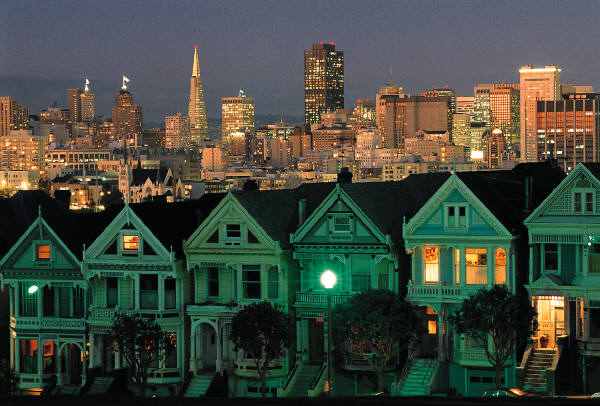
^ EDUCATION IN SCOTLAND
Scots education is highly thought of throughout the world. Scotland , which had five universities as a time when England only had two, has a long history of universal public education.
The Scottish education system has maintained distinct differences from other parts of the United Kingdom. Traditionally their system has emphasized breadth across a range of subjects, while the English system focused on depth over a smaller range of subjects at secondary school lever.
The Scottish summer holidays run from the end of June to the middle of August, usually two weeks ahead of those in England although the dates of holidays are left to individual local education authorities.
Scottish universities gained a good reputation and Edinburgh became the medical center of Europe; many students were attracted to the Royal College of Physicians and the Surgeons. The University of Edinburgh began from 400 students at the start to 2000 by 1815. Also in Edinburgh around 1760, numerous private schools opened, four “English schools” were founded, and the Royal High School doubled in size in 1790, claiming to be the largest schools in Britain.
In the Scottish Highlands, in addition to problems of distance and physical isolation, most people spoke Gaelic which few teachers could understand. Societies arose to teach the English language and end Roman Catholicism, while through the Gaelic Society taught the Bible in Gaelic. The overall effect contributed to the erosion of Highland culture.
Education became compulsory for all children between 5 - 13 with the Education Act 1872 . At this point, 80 percent of Scottish children were already in school.
Many famous people were born and educated in Scotland, Edinburgh. Scotland gave a great number of people that contributed to the world culture and science .
I would like to tell you about famous Scottish writers.
^ Scottish writers
The Scottish people have a reputation for their strong oral tradition in song and story, as well as their high literacy and keenness for education. Not surprisingly, therefore, Scotland has produced many world-renowned authors.
Sir Walter Scott (1771 – 1832) ,father of historical fiction and popularizer of the Highlands. He was born is Edinburgh. Many of his books, including his most famous, “Ivanhoe”, take place in England.
^ Robert Burns (1759 – 1796), national poet and Hero of Scotland . Scots around the world celebrate January 25 as Burns Night. He wrote many poems. Example: “Chiefly in the Scottish Dialect” (1786), “The Scots Musical Museum” (“Auld Lang Syne”).
Robert Louis Stevenson (1850-1894), writer of adventure and horror stories and verses.He wrote many novels: ”Treasure Island”, ”Kidnapped”, “Jekyll and Hyde”.
^ Sir Arthur Conan Doyle (1859-1930), the best mystery writer Edinburgh’s of medicine ever produced.
John Logie Baird (1888 – 1946). Baird, was the first man to televise the objects in motion. Alone at Hastings, Baird discovered how to transmit and receive recognizable images. Baird became the first person to televise images across the Atlantic in 1928.
^ Alexander Graham Bell (1847 – 1922). Bell, the remarkable inventor and teacher of the deaf was born in Edinburgh. In 1875, when testing a harmonic telegraph, he transmitted his own voice. Bell was issued a telephone patent the next years.
Sir Alexander Fleming (1881 – 1955). In 1928, while working with bacteria, he discovered a substance he called “penicillin”. Fleming was knighted in 1944 and won Nobel Prize for Medicine in 1945.
^ David Livingstone (1813 – 1873). In 1853, he began his first expedition for new trade routes through Africa, returning to Britain in 1856 as a hero. His second expedition, up the Zambezi River, was a disaster. When Livingston died in 1873, he was buried in Westminster Abbey.
Scottish food and drink
Traditional food can explain some traits of the national character. For example, people living in hot climate prefer spicy food, people living in cold countries prefer meat and rich soup. And what about the Scottish?
Traditional Scottish food consists of a hearty barley-vegetable soup (Scotch broth), Scotch pies (pot) stovied tatties (potatoes).Not being rich, Scots cooking relies on basic ingredients cooked up to provide warmth, strength and energy- a “meat and potatoes” diet. Vegetables grown and eaten in Scotland include potatoes, turnip, carrots, cabbage, peas and cauliflower-all suitable for their climate.
While the Lowlanders relied on mutton, the Highlanders always preferred beef. The Aberdeen-Angus breed of beef cattle are now widely reared across the world and renowned for their rich and tasty meat, which makes excellent steaks.
Living in the land of isles, lochs and burns, fish and seafood have always been Scottish staples. Today salmon tends to be smoked and thinly sliced, served as an entrée. A wide variety of seafood in the diet includes mussels, scallops, shrimps and some of the world’s finest lobster and crab.
The Scottish people have a “sweet tooth”, and are farmed for shortbread, scones and other wonderful treats, many relying on honey and berries for their sweet flavour. Traditionally, oatmeal and barley are basic to most Scots recipes, though wheat flour is often used today. Oatmeal was once described as “the backbone of many sturdy Scotsman”.
The Scots make and eat a lot of cheese called “crowdie”, made from the whey of slightly soured milk, seasoned with salt and a touch of pepper. The seasoned whey is squeezed in muslin bag to remove excess water, left for two days and rolled in oats and served.
Today Scots often buy tea at neighbourhood “takeaways” and “chippies” 9fish-and-chip shops), which often offer haggis, sausage and meat pies. The Asian Subcontinent has revolutionized Scottish dining. Thanks to immigrants from India and Pakistan, excellent Asian cooking can now be found in most Scottish towns, and “going out for a curry” become an integral part of Scottish life.
Bannocks (oatcakes) A barley and oat-flour biscuit traditionally was baked on a griddle, but today a heavy frying pan is used. Bannocks are often eaten with cheese.
Black Bun is a very rich fruit cake made with raisins, currants, finely-chopped peel, chopped almonds and brown sugar, with cinnamon and ginger added. Its name comes from the very dark colour. This traditional treat is often eaten at Hogmanay, but it should be made several weeks in advance so that it can mature.
Scotch eggs. This popular dish is served either hot or cold at picnic, using sausage meat, peeled hard boiled eggs, breadcrumbs, flour, eggs, water and seasoning.
Scotch broth or Hotch-Potch . A rich soup stock usually made by boiling mutton, beef, marrow-bone or chicken. Added to this is a choice of diced vegetables-carrots, garden [peas, leek, cabbage, turnip and a stick of celery . The hard vegetables are added first to the boiling stock with a handful of Barley, and the softer vegetables are added last. The final consistency is thick and served piping hot.
Cock-a-Leekie Soup. This traditional chicken, bacon and leek soup is mentioned as early as the 16th century. It is often served at Burns Suppers or St Andrew’s Night Dinner as well as an every-day soup in winter.
Scotch pies. A round crusty pastry pie, approximately 10 cm in size. They are filled with minced meat (mutton or beef with onion), becoming a thick buttery pastry with a baked meat filling.
Haggis. It is the best known Scottish delicacy, it has a rich flavour.
Robert Burns said about Haggis :
Fair fa’ yer honest, sonsie face,
Great chieftain o’ the pudden race!
Haggis is made from sheep’s inner organs which are boiled and then minced. This is mixed with beef suet and toasted oatmeal. This mixture is placed inside the sheep’s stomach, which is sewn closed and cooked up to 3 hours by boiling and in the oven.
Porridge should be thick and wholesome with salt to obtain the correct flavour. They make a large pot of porridge at the beginning of the week, then cool it , cut up into slices and take it in the food box .each day for lunch.
Scottish drinks.
^ From the bonny bells of heather,
They brewed a drink Lang Syne
Was sweeter far than honey
Was stronger far than wine.
R.L.Stevenson. (A Galloway Legend)
Heather ale is very popular. It has been used over the years to flavour different food and drinks.
Hot Toddy. You need a teaspoon of sugar, Scottish heather honey in a warm glass.
Add a measure of whisky and top up boiling water, gently stir. It is an excellent cure for the common cold, when feeling down.
Scottish Whisky or simply Scotch is the best known Scottish drink. There are two basic classes of whisky: 1) Malt Whisky –more expensive; 2) Blended Whisky-cheaper and more popular.
The first documentary evidence of whisky was in the late 15th century. In Gaelic “whisky” means “the water of life”.
Food and drinks are tensely connected with celebrations and festivals.
^ FESTIVALS IN SCOTLAND
EDINBURGH INTERNATIONAL FESTIVAL. The Edinburgh international Festival presents a rich program of classical music, theatre, opera and dance in 6 major theatres and concert halls and a number of smaller venues, over a 3-week period in late summer each year. The mission of the Edinburgh Festival is to be the most exciting, innovative and accessible Festival of the performing arts in the world, and thus promote the cultural, educational and economic well-being of the people of Edinburgh and Scotland. From the beginning the Festival has presented performances of the highest possible standard, involving the best artists in the world. In addition, the Festival has a year-round program of education and outreach work, aimed at all ages.
^ Scottish sport
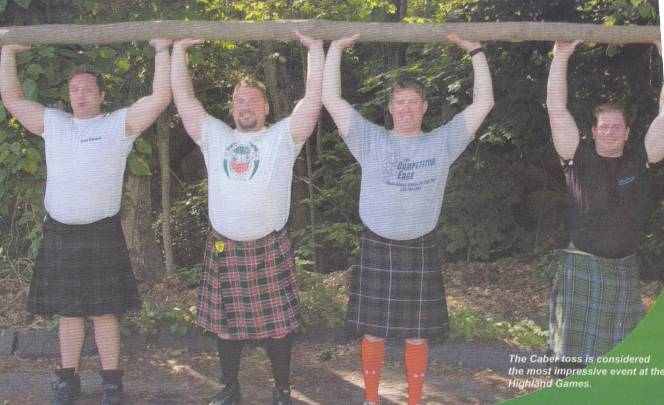 The Highlands games go back to contests of strength among the clans in ancient times, a way for the chiefs to choose the strongest men as their warriors. In the 11th century Scottish King Malcom III organized contests called Braemar to find the strongest the fastest men in his kingdom. The strongest became the king’s bodyguards, the fastest became his messengers. The Games were very spectacular and many people came to Braemar when the contest was held. Some wanted to take part, others just came as visitors.
The Highlands games go back to contests of strength among the clans in ancient times, a way for the chiefs to choose the strongest men as their warriors. In the 11th century Scottish King Malcom III organized contests called Braemar to find the strongest the fastest men in his kingdom. The strongest became the king’s bodyguards, the fastest became his messengers. The Games were very spectacular and many people came to Braemar when the contest was held. Some wanted to take part, others just came as visitors. 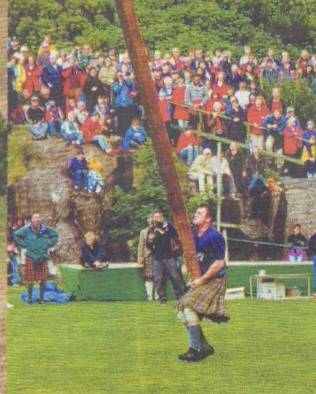 Standard Highlands athletic events are caber toss, stone put, hammer throw, weight throw, sheaf toss, weight over the bar. There are also competitions in bag-piping and dancing. The atmosphere is great! One can meet Scottish people, learn a little about their history, listen to Scottish music and enjoy great Scottish food and drink. Men wear traditional Scottish kilt, a sporran and a small knife.
Standard Highlands athletic events are caber toss, stone put, hammer throw, weight throw, sheaf toss, weight over the bar. There are also competitions in bag-piping and dancing. The atmosphere is great! One can meet Scottish people, learn a little about their history, listen to Scottish music and enjoy great Scottish food and drink. Men wear traditional Scottish kilt, a sporran and a small knife.2007 was a special year for Scotland and Highlands. Hundreds of events and activities took place celebrating Highland culture in villages, towns, cities throughout Scotland. Now the Games do not only take place in Scotland , but also in many other countries where the Scottish people have settled. The Highland Games open and close with impressive ceremonies.
Golf. Golf originated during the 15th century from a game played on the east coast of Scotland where a pebble would be hit using a stick or club. The game was played on links or linklands lying between fields and the seashore. By 1457 it was so popular that the Scottish King James II banned it because too many Scots were out golfing instead of attending mandatory archery practice for national defense. They say that golf was first the play of shepherds. The oldest golf course in Scotland , Musselburgh Links, dates from 1672. The most renowed golf course in the world, the Royal & Ancient Golf Club of St. Andrews, was founded in 1754 by “
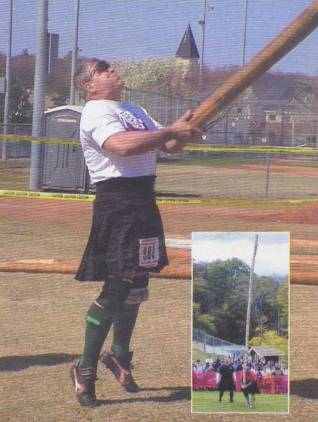 22 Noblemenand Gentlemen of the Kingdom of Fife”.After 1750, golf envolved into modern sport we know today. In 1774, the first standardized rules for the game were written.
22 Noblemenand Gentlemen of the Kingdom of Fife”.After 1750, golf envolved into modern sport we know today. In 1774, the first standardized rules for the game were written. Curling. Extraordinary kinds of sport are very popular activities nowadays. People want something unusual in their common life. Curling seems to be a new kind of sport, but it is not so new. It is likely that modern curling has its origins in Scotland, in the early part of the 16th century, as а primitive game of quoits оn ice. The introduction of rounded stones, of artificial ice, of playing four-aside, and the discovery of the ’curl' or the 'twist', can be chronicled in Scottish curling records. Curling is like bowling оn ice, where players plау their bowls with the aim of ending up nearest the target. At the same time, it is also essential to ensure that the opposition cannot do anything about it! In normal Rinks plау, each team has four players - the Lead, Second, Third and Skip. The Skip gives instructions to the other players, both as to the line in which the stone shall be sent and the weight with which it should be delivered. А third important component is the "handle" - the direction of rotation with which the skip wishes the stone to be sent up the ice. In addition to delivering his two stones at each end, а player mау also be involved in vigorously sweeping in front of the stones of his other team members. Sweeping can affect the distance which а stone will travel up the ice and the degree to which it draws.
Shinty.The game of shinty goes back to Gaelic Scotland and the even earlier heritage of the Celtics. Its demands of skill, speed, stamina and courage make camanachd, the sport of the curved stick, the perfect exercise of а warrior реорlе, and clearly contributed to the fame of the Highlander in battle. Shinty evolved from а long history and widely differing local variations in the last quartet of the 19th Century. In 1879 the Glasgow Celtic Society instituted а сup competition and established rules of plау. In 1893, enthusiasts met in Kingussie and the Camanachd Association was formed "to foster and develop the national game of shinty". The Camanachd Association focuses particularly оn the fostering of shinty in primary school and beyond. А major problem has been the loss of young players between the ages of 12 and 15.
Hiking.British people have different hobbies. Some of them are English , some of them are Scottish or Irish or Welsh. But all of them have common interests. Let us speak about Scottish pastime.
Scotland has literally thousands of hills ranging from the smallest humps to towering mountains. Mountains are Scotland's trademark, being home to the 42 highest mountains in the whole of Great Britain and they are attracting more and more hikers. Hill "Bagging" -perhaps the catalyst for hill traffic are"lists". Long ago, а few notable climbers compiled lists of hills which fell into certain categories. The main purpose of the exercise was to plot the lау of the land, but in recent times the objесtive for many people is to climb аll the hills оn these lists.
Munro is а Scottish mountain over 3,000 ft. There are 284 . Munro, the name coming from tables compiled by Sir Hugh Munro, first president of the Scottish Mountaineering , club who published them in 1891. Over 2,500 peoplе have climbed them аll.
Corbett is а separate mountain over 2,500 ft. Distinct Corbetts must have а 500 ft drop between them. The Corbetts are named after John Rooke Corbett. There are currently 220 Corbetts and these, too, have become а tick list for hill baggers.
The Donalds is а collective name given to аll the mountains in Lowland Scotland which are over 2,000 feet. The classification was given its name by Percy Donald who published а table. Donald-''bаgging'' is not nearly as popular, since Donalds are smaller and the terrain is considered to be more difficult, with deep heather and rough ground.
The Grahams are named after Fiona Torbet who published her own list of these peaks in the early 1990s. The Grahams are аll the distinct mountains in Scot1and which are between 2,000 and 2,499 feet (610 and 761 metres), and which have at least а 150 metre drop between them. There are 224 separate Grahams - even seven of the Islands contain Grahams.
Fishing.Fly fishing for trout is almost certainly the most popular branch of аngling in Scotland. It takes plасе оn lochs (lakes) and rivers throughout the country and offers а huge element of variety. The traditional method of loch fishing - two or three anglers fishing small wet flies from а drifting boat - is known as "loch-style" fishing and it forms the basis for competitive angling in national and international tournaments. The Atlantic salmon is often regarded as the "King of Fish" and Scotland hosts most of the greatest salmon rivers in the British Isles. Names like the Tweed, Тау, Spey and Dee are known throughout world as prime locations for the sport. . Swimming.You don't have to be mad to take part in the Loony Dook, but it helps! Every New Year's Day, а group of hardy souls brave the cold and take а dook (Scottish slang for swim) in the Firth of Forth at South Queensferry, near Edinburgh, аll in the name of charity. Fanсу dress is welcomed, but no wetsuits are allowed! All those brave enough to take part get а free hot whisky and soup. But if you can't face the water, it's also а fun event to watch.
^ THE SCOTTISH BAGPIPE
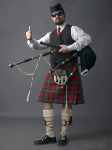 When people think about Scotland, they imagine a real Scotsman in a kilt with a bagpipe. Bagpipes are found in many countries besides Scotland, but they have become so linked with Scotland that the country and its ubiquitous instrument are practically synonymous. Pipes take different shapes and forms, and though formerly used in pastoral celebration, today they are used for every kind of festival occasion. And the piping in of the haggis on “Robbie Burns Night” is celebrated in whatever corner of the world Scots gather on January 25.
When people think about Scotland, they imagine a real Scotsman in a kilt with a bagpipe. Bagpipes are found in many countries besides Scotland, but they have become so linked with Scotland that the country and its ubiquitous instrument are practically synonymous. Pipes take different shapes and forms, and though formerly used in pastoral celebration, today they are used for every kind of festival occasion. And the piping in of the haggis on “Robbie Burns Night” is celebrated in whatever corner of the world Scots gather on January 25. Although the early history of the bagpipe is still unclear, it seems likely that the instrument was first developed in pre-Christian times. It probably comes from something like a hornpipe. Where or when a bag was first attached to one these instruments is likely to remain mystery. The earliest secular reference to a bagpipe occurs around 400BC, the Athenian poet joked that the pipers of Thebes blew piper made of dog skin with chanters made of bone. Several hundred years later, Suetonius described the Roman Emperor Nero as a player of the tibia utricularius,. The Romans may well have spread the pipes through the Roman Empire, but there is little evidence for this.
Prior to the 12th Century, only a few Pictish and Irish stone carvings record the continued existence of bagpipes during the Dark Ages. Ireland has references going back at least to the Middle Ages, as well as stone carvings which date back to the 8th Century.
An explosion of popularity seems to have occurred from around the 12th Century; the tune used by Robert Burns, “Hey Tutti Taiti”, is traditionally said to have been the tune played as Robert the Bruce’s troops marched to the Battle of Bannockburn in 1314. During this time, Europe underwent a flourishing of art and culture as her horizons were expanded with the crusades. The bagpipes were no exception, and many of Europe’s unique bagpipes began to develop around this time. The role of bagpipe in Britain was as a common adjunct to religious festivals. Pipers also became part of the traveling minstrel class, acting as carriers of news, gossip and music around the country. In the Scottish Highlands, the pipers started to displace the harpers, the chief musicians since Roman times, round about the 16th century.
Soon, Scottish Highland pipes were well establishes as military instruments. Their stirring music has been adopted by military bands all over the world. They have led Scottish soldiers into battle for centuries. In World Wars I and II, the ominous wail of the pipes that preceded the Highland charge of the kilted Scottish infantry regiments, often created panic among the enemy troops.
As Western classical music developed, bagpipes in many regions fell out of favour. But, with the growth of the British Empire, the Great Highland Bagpipe has become well-known world-wide.
In the Modern Era, the use of bagpipes has become a common tradition for military funerals and memorials in the Anglophone world. Weddings, dances and parties are also venues for piping, in fact any social event can be given a lift by the addition of this unique instrumental music. In English-speaking regions, a bagpipe player is known as a “bagpiper” or “piper”, and family surname Piper derives from the latter term. Dozens of types of bagpipes today are widely spread across Europe and the Middle East, as well as through much of the former British Empire. The name “bagpipe” has almost become synonymous with its best-known form, the Great Highland Bagpipe.
In the Great Highland Bagpipe world, there are hundreds of pipe bands registered with pipe band associations world wide, mostly averaging ten of twelve pipers. There are many more pipers who do not play with bands. Estimates for the number of GHB players worldwide usually suggest a figure between 10-50,000 players.
Traditionally, bagpipes provided music for dancing. This has declined today but has to many of pipes developing a performance-led tradition. Over the past 30 or so years, bagpipes have also made appearances in other forms of music, including rock, jazz, and classical music, notably with Paul McCartney’s “Mull of Kintyre” and the Peter Maxwell Davies composition Orkney Wedding, With Sunrise.
Bagpipes today are probably as popular as they have ever been in history; one4 Scottish maker produces forty sets of pipes per week for sale worldwide. Pipe band associations report continued growth and the number of commercial recordings of bagpipes continues to grow year on year. In every country, the basic bagpipe comprised a bag with a chanter and one or more drones. Today, it is the Highland bagpipe or the piob-mhor ‘the Great Pipe’, which has emerged as the national instrument. These are blown by mouth and the bags were traditionally made from the skin of a sheep, although nowadays leather, rubber or other synthetic materials are used. The pipes themselves were originally made of bone or ivory, but hardwood is the modern choice. The melody is played on a reeded chanter leading down from the bag while the three drone piper’s shoulder and provide a constant, steady sound as a background to the melody.
There are essentially two types of music played on the Highland pipes: the march, strathspey and reel variety, which were composed for military or social events, and the priobaireachd (pronounced “pee-broch”) which is the ‘symphony music’ of the pipes. This classical music is an art form which can compare to the music of the music of any other country and most of it was composed 100 years before the piano and without written notation. So while they did not invent bagpipes, Scots can fairly claim to have made them their own through keeping them alive as part their musical tradition and by making them one of the outstanding parts of their culture.
 THE KILT. The tartan kilt has long been the most recognizable cultural tradition of the Highland Scots. Yet, many of the most common features and associated with the wearing of the kilt were, in fact, developed in the 19th century, not by Scottish Highlanders, but by the Nobles of England and Scotland. A traditional Scottish kilt is made with 8 yards of material – always 100 percent wool. It should sit high on the waist, with the bottom edge at the center of the knee. It costs from $400 to $700. Eight-yard kilts weigh a heavy 6 pounds and swing rhythmically when marching or dancing. Four-yard, or casual, kilts use half the material and cost less. Even so, casual and traditional kilts are generally acceptable at both formal events.
THE KILT. The tartan kilt has long been the most recognizable cultural tradition of the Highland Scots. Yet, many of the most common features and associated with the wearing of the kilt were, in fact, developed in the 19th century, not by Scottish Highlanders, but by the Nobles of England and Scotland. A traditional Scottish kilt is made with 8 yards of material – always 100 percent wool. It should sit high on the waist, with the bottom edge at the center of the knee. It costs from $400 to $700. Eight-yard kilts weigh a heavy 6 pounds and swing rhythmically when marching or dancing. Four-yard, or casual, kilts use half the material and cost less. Even so, casual and traditional kilts are generally acceptable at both formal events.Kilts don’t have pockets, so the sporran is used for keys, money, and often a flask. Sporran comes from the Gaelic word sporran – meaning a purse or a pouch. Sporrans are worn at the front of a kilt, hung from chains attached to the wearer’s wide leather belt. Older sporrans were modest, functional items made of leather, but over the years they became more elaborate.
By the Victorian era, sporrans – especially those that were part of the uniforms of kilted Scottish Highland regiments in the British Army – hand become highly elaborate. Today, sporrans are usually made of plain leather for day wear. Sporrans made from animal furs are popular for evening wear.
Next up in importance are hose, which come up to three fingers below the kneecap; ribbons around the top of the hose known as garter flashes; and decorative daggers called sgian dubh (skee-in dooh). Traditional shirts, jackets, and shoes are expected only at formal events. At black-tie galas, the choices are a tuxedo shirt, worn with a bow tie, jacket, and vest, or a fluffy shirt with a cravat that’s also worn with a jacket. Broguest, the tongue less shoes that go with the outfit, have laces that wrap around the ankle and tie in front. At casual events, you can wear wool socks, hiking boots, and a rugby shirt, T-shirt, or sweater.
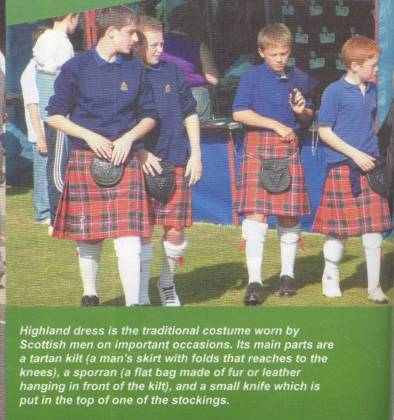
^ A typical Scottish
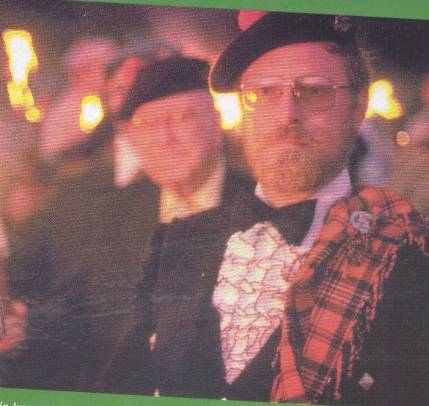 What information have we got about a typical Scottish person? Let us sum up.
What information have we got about a typical Scottish person? Let us sum up.We know that “Mac” or “Mc” means that a person is from Scotland. Sometimes as a joke , Scotsmen are called ‘Jock’ or ‘Jimmy’, Irishmen are called ‘Paddy’ or ‘Mick’ and Welshmen are called ‘Dai’ or ‘Taffy’. But if you don’t know someone well, don’t call them by these names!
The Scots are very proud of their national songs. When the Scottish play football against England or Wales, they sing “^ Flower of Scotland.”
The most famous traditional British dress is undoubtedly the Scottish kilt. Many people think that the Scottish men wear it every day. It is not true! Just like no Russian woman wears ‘’kokoshnik’’ every day. So kilts are for special occasions such as weddings or dances. When you see a man in a kilt, he is probably not Scottish , he is probably an American tourist.
What about the national character ? The Scots , as the Welsh and the Irish, are the Celts. But the English are Anglo-Saxon in origin. The Scottish ancestors were brave and strong , rugged warriors.
If the Irish are supposed to be great talkers, the Scots have the reputation of being careful with money. It may have originated from the days when most people were poor and needed to watch their pennies. Nevertheless, the Scots give to charity more per head than any other part of the UK.
The national character can be seen in the national humour. It is said that the Scottish people have a good sense of humour- because it is a free gift!
^ Scottish humour
They say that the Scots have an infallible cure for sea-sickness. They lean over the side of the ship with a ten pence coin in their teeth.
In some Scottish restaurants, they heat the knives so you can not use too much butter.
Have you ever heard the rumour that the Grand Canyon was started by a Scotsman who lost a coin in a ditch ?
Do you know why are the Scots so good at golf ? Because they realise that the fewer times they hit the ball the longer it will last.
A typical Scottish prayer is “Oh Lord , we do not ask you to give us wealth, but show us where is it!”
McTavish broke the habit of a lifetime and bought two tickets for a raffle. One ticket won a 1,000 pound prize. He was asked how he felt about his big win.
“Disappointed!” he said. “My other ticket didn’t win anything.”
One day Jock bought a fine whisky and while walking home he fell. Getting up he felt something wet on his pants. He looked up at the sky and said, “Oh Lord, I beg you let it be blood.”
You should be careful about stereotyping the Scots as mean. There was a recent letter to a newspaper from a Scot, “If you print any more jokes about mean Scotsmen I shall stop borrowing your paper.”
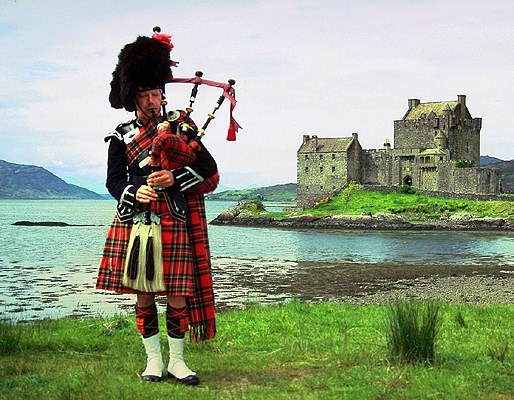

Test on Scotland
Level A. Elementary.
1.The capital of Scotland is _____________
2.The family group of Scotland , especially those in the Highlands, are called______
3. A ball game which began in Scotland is_________________
4. Scotland is not an independent country but part of______________
5.The northern hills of Scotland are called_________________
6. The most famous poet of Scotland is___________________
7.The skirts worn by Scottish men are called_______________
8. Much traditional Scottish music is played on an instrument called the_______
9.Many famous and beautiful medieval__________still stand in Scotland and some are still lived in.
10. The Scottish ________is called the “Saltire” and is a white “X” on a blue background.
Level 2. Intermediate.
1.A type of musical instrument, played especially in Scotland and Ireland. The sound comes from blowing air into a leather bag and forcing it out.
2.A strong alcoholic drink originally made in Scotland.
3.Annual celebration and tribute to life, works and spirit of Scotland’s greatest poet.
4.A type of thick Scottish porridge served with milk or cream.
5. A Scottish game played outside with a small ball hit a long distyance into small holes in the ground.
6. The famous Scottish Queen who grew up in France and lost her head in Scotland.
7. The floral emblem of Scotland.
8. The Scottish writer who penned “Treasure Island”.
9. The largest city in Scotland dating from the 6th century,
10.One of the most famous lakes in the world, said to be the home of a monster.
11. Name of the Scottish heroic Warrior King.
12. Britain’s highest, mountain located in Scotland.
13. The last day of the year in Scotland .
14. A group of families who originated from the same ancestor and who have the same name.
15. An outdoor competition that happens every summer in Scotland which involves dancing, music and unique sport.
Conclusion
Well, my travelling around Scotland is coming to the end. They say, “A new country is a new world.” It is true. My discovering of this part of the UK turned out to be very exciting and informative. I have found many interesting facts about people, historical and cultural events of Scotland .
It was interesting to know about the national traits of Scottish character (their humour is very strange and sometimes difficult for me to understand). I was impressed with the history of the kilt and national instrument –the bagpipe. I did not know before that the Scots have Celtic roots , that they differ from the English in origin.
Now I know that the word “loch” means “lake”. Moreover, I believe in the Loch Ness monster. Maybe one day I shall visit Scotland and see Nessie. I hope I shall see beautiful lakes and rivers of Highland, vast fields of heather , I shall watch the Highland games and hear the sounds of Scottish bagpipe, I shall explore the ruins of old castles and feel their specific historical atmosphere. I hope…

Used literature
1. Nesterova N.M. Great Britain.- Rostov on/D.: «Feniks» 2006, 367 p.
2. Golitsinsky U.B. Great Britain.-St-Petersburg: «Karo» 2002,477 p.
3. English № 5. – М.: «1 September» 2006, 48p.
4. English № 16. – М.: «1 September» 2008, 48p.
5. Speak out.-M.: «Glossa Press» 2009,31 p.
6. Internet
Список литературы
- Нестерова Н.М. Страноведение Великобритании.-Ростов н/Д.: «Феникс» 2006, 367 стр.
- Голицинский Ю.Б. Великобритания.- СПб.: «Каро» 2002, 477 стр.
- Английский язык №5.- М.: «Первое сентября» 2006, 48 стр.
- Английский язык №16.-М.: «Первое сентября» 2008, 48 стр.
- Speak out.-М.: «Глосса Пресс» 2009, 31 стр.
- Интернет
